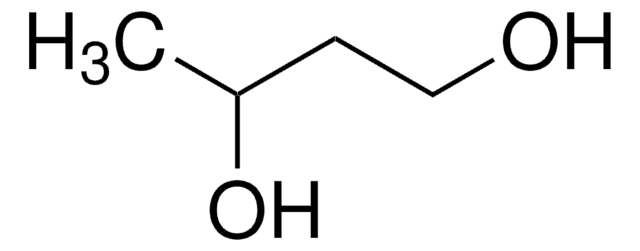1193265
USP
Diethylene glycol
United States Pharmacopeia (USP) Reference Standard
Synonym(s):
2,2′-Oxydiethanol, 2-Hydroxyethyl ether, Bis(2-hydroxyethyl) ether, Diglycol
About This Item
Recommended Products
vapor density
2.14 (vs air)
vapor pressure
0.01 mmHg ( 20 °C)
API family
diethylene glycol
autoignition temp.
442 °F
expl. lim.
2-12.3 %
manufacturer/tradename
USP
refractive index
n20/D 1.447 (lit.)
bp
245 °C (lit.)
mp
−10 °C (lit.)
density
1.118 g/mL at 25 °C (lit.)
application(s)
pharmaceutical (small molecule)
format
neat
SMILES string
OCCOCCO
InChI
1S/C4H10O3/c5-1-3-7-4-2-6/h5-6H,1-4H2
InChI key
MTHSVFCYNBDYFN-UHFFFAOYSA-N
Looking for similar products? Visit Product Comparison Guide
General description
Application
- Propylene Glycol
- Glycerin
- Polyoxyl 40 Hydrogenated Castor Oil
- Sorbitol Solution
- Polyethylene Glycol 3350
- Maltitol Solution
- Noncrystallizing Sorbitol Solution
Analysis Note
Other Notes
related product
Signal Word
Warning
Hazard Statements
Precautionary Statements
Hazard Classifications
Acute Tox. 4 Oral
Storage Class Code
10 - Combustible liquids
WGK
WGK 1
Flash Point(F)
280.4 °F - closed cup
Flash Point(C)
138 °C - closed cup
Regulatory Listings
Regulatory Listings are mainly provided for chemical products. Only limited information can be provided here for non-chemical products. No entry means none of the components are listed. It is the user’s obligation to ensure the safe and legal use of the product.
FSL
Group 4: Flammable liquids
Type 3 petroleums
Hazardous rank III
Water soluble liquid
ISHL Indicated Name
Substances Subject to be Indicated Names
ISHL Notified Names
Substances Subject to be Notified Names
JAN Code
1193265:
1193265-0.5ML:
1193265-5X0.2ML:
Certificates of Analysis (COA)
Search for Certificates of Analysis (COA) by entering the products Lot/Batch Number. Lot and Batch Numbers can be found on a product’s label following the words ‘Lot’ or ‘Batch’.
Already Own This Product?
Find documentation for the products that you have recently purchased in the Document Library.
Customers Also Viewed
Protocols
99%; Glycerol, ≥99.5%; Tetraethylene glycol, 99%
Our team of scientists has experience in all areas of research including Life Science, Material Science, Chemical Synthesis, Chromatography, Analytical and many others.
Contact Technical Service









